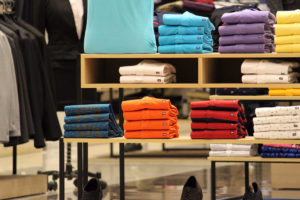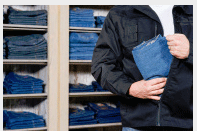 December is the month when retailers are focused on driving those end of the year sales. We push as much merchandise as possible out of the stockrooms to fill the floors. Empty salesfloor spaces should be “no-no’s” during this time of the year. We re-merchandise our fixtures to get gift ideas in front of our customers. We also take steps to increase impulse buys by filling check lanes with snacks, batteries, magazines, gift cards, etc. Managers should also be looking at last year sales information to plan schedules around peak times of the day in order to avoid long lines at the registers. While all of this is important it is just as important to start planning for your end of the year wrap up.
December is the month when retailers are focused on driving those end of the year sales. We push as much merchandise as possible out of the stockrooms to fill the floors. Empty salesfloor spaces should be “no-no’s” during this time of the year. We re-merchandise our fixtures to get gift ideas in front of our customers. We also take steps to increase impulse buys by filling check lanes with snacks, batteries, magazines, gift cards, etc. Managers should also be looking at last year sales information to plan schedules around peak times of the day in order to avoid long lines at the registers. While all of this is important it is just as important to start planning for your end of the year wrap up.
Much of December into January is the same as the rest of the year but there are some differences that need to be considered. It is the end of the year and that means you will have to consider inventory will be coming up in the next few months (depending on when you take inventory of course). Even if you take your inventory later in the year you should still be thinking about it and starting to prepare now. As your team is pushing merchandise out of the stockroom it should be emptying out. It is the perfect time to look for merchandise that has fallen from hangers or dropped into a nook or cranny that is usually hard to see. Scouring the building for merchandise that has been hidden away is another step to be taken. Sometimes customers will hide merchandise intending to come back for it later or employees may do so to avoid re-stocking it. Merchandise may also be under base decks or fall behind registers and regardless of how it gets there, it will result in shortage if not accounted for at inventory time.
You may have hired seasonal employees for the holidays. You will need to start making decisions on who you will release and who you may decide to keep on your staff. If you have other managers working for you seek their input. It is not uncommon for us to have a skewed view of what an employee’s work and productivity may be. You may see someone occasionally and think they are performing well. You then speak with their immediate supervisor and find out this employee is really a problem to their work center. Decisions must be made as to when cuts will be made and offers of permanent employment provided. Whether you like the employee or not it is only fair to give them time to start looking for other work or have the knowledge they won’t need to do so.
Review any vendor supplied items your store may carry. Are vendors maintaining their products and filling their allocated space? Conduct spot audits of vendor merchandise and make sure if there are products soon to expire they are on the front of the shelf. Be diligent that you are receiving the appropriate credits for merchandise the vendor is removing from your store. You or a delegated manager should look at vendor credits to be sure they are being given to you in a timely manner now and through the entire year.
The end of the year is also the time to look at building maintenance issues. Parking lot lighting, exterior lights, fire, and burglary alarm tests should have all been done at the start of the 4th quarter. Now is the time to look for facility problems, are restroom sinks and toilets operating correctly? Are there any roof leaks that have not been previously reported? Are fitting room doors opening, closing and locking? Some repairs may be a landlord’s responsibility to cover, be sure those are reported and taken care of.
Finally, as you wrap up your year take time to celebrate your wins with your team and also take a look at opportunities for improvement. Make it a group effort and give everyone a chance to comment on what they thought went well and what could have gone better. Getting everyone’s insight can be enlightening and provide ideas for making the coming year even better than this year and that is how businesses stay successful.

 As a manager of a retail shop, the layout of the store is probably out of your hands and there is nothing to do about it.
As a manager of a retail shop, the layout of the store is probably out of your hands and there is nothing to do about it. As the biggest shopping season of the year seems inevitable close, retailers across the world prepare themselves to not only have a great holiday season but a profitable one.
As the biggest shopping season of the year seems inevitable close, retailers across the world prepare themselves to not only have a great holiday season but a profitable one. According to the Small Business Administration (SBA), there are more than 28 million small businesses in the United States and they account for more than 99% of businesses in the country. Small businesses employ close to 57 million people in the United States alone and are a driving force in the progress of the US economy. The good news for an entrepreneur that wants to start a business is that they are not alone, but if you are a small business in the retail industry, the problems you will encounter do not come as paperwork filings or taxes paid. Shoplifting and employee theft are two of the major causes small retail shops face financial distress during their business enterprise. It is an unfortunate problem, but the problem is there and the small business owner has to find solutions to the specific problems in their store.
According to the Small Business Administration (SBA), there are more than 28 million small businesses in the United States and they account for more than 99% of businesses in the country. Small businesses employ close to 57 million people in the United States alone and are a driving force in the progress of the US economy. The good news for an entrepreneur that wants to start a business is that they are not alone, but if you are a small business in the retail industry, the problems you will encounter do not come as paperwork filings or taxes paid. Shoplifting and employee theft are two of the major causes small retail shops face financial distress during their business enterprise. It is an unfortunate problem, but the problem is there and the small business owner has to find solutions to the specific problems in their store. It might be too early for retailers to prepare for the holiday season, but it is never too early to implement security measures to prevent shoplifting in their stores. The holiday season attracts more customers than at any other time of the year, therefore shoplifting incidents increase with the increase of customers as well.
It might be too early for retailers to prepare for the holiday season, but it is never too early to implement security measures to prevent shoplifting in their stores. The holiday season attracts more customers than at any other time of the year, therefore shoplifting incidents increase with the increase of customers as well.
 Turnover for many businesses can be a real headache. You take the time to post job ads, review job applications, set up interviews and then conduct the interviews. Your new hire starts and within a couple of weeks they quit. It happens far too many times and it is a pain. Why did the person quit? Did they have a propensity for job hopping already and you missed it on the job application? Did they start stealing from you and got enough money or merchandise and quit before you caught on to their schemes? Perhaps it was a young employee on their first job and they wanted more weekends and night shifts off so they could “hang out” with their friends. All of these are reasons for high turnover in retail stores especially. Lose too many people at once and it can cripple your business, stretch the staff you currently have and it may potentially lead to more employees quitting.
Turnover for many businesses can be a real headache. You take the time to post job ads, review job applications, set up interviews and then conduct the interviews. Your new hire starts and within a couple of weeks they quit. It happens far too many times and it is a pain. Why did the person quit? Did they have a propensity for job hopping already and you missed it on the job application? Did they start stealing from you and got enough money or merchandise and quit before you caught on to their schemes? Perhaps it was a young employee on their first job and they wanted more weekends and night shifts off so they could “hang out” with their friends. All of these are reasons for high turnover in retail stores especially. Lose too many people at once and it can cripple your business, stretch the staff you currently have and it may potentially lead to more employees quitting.